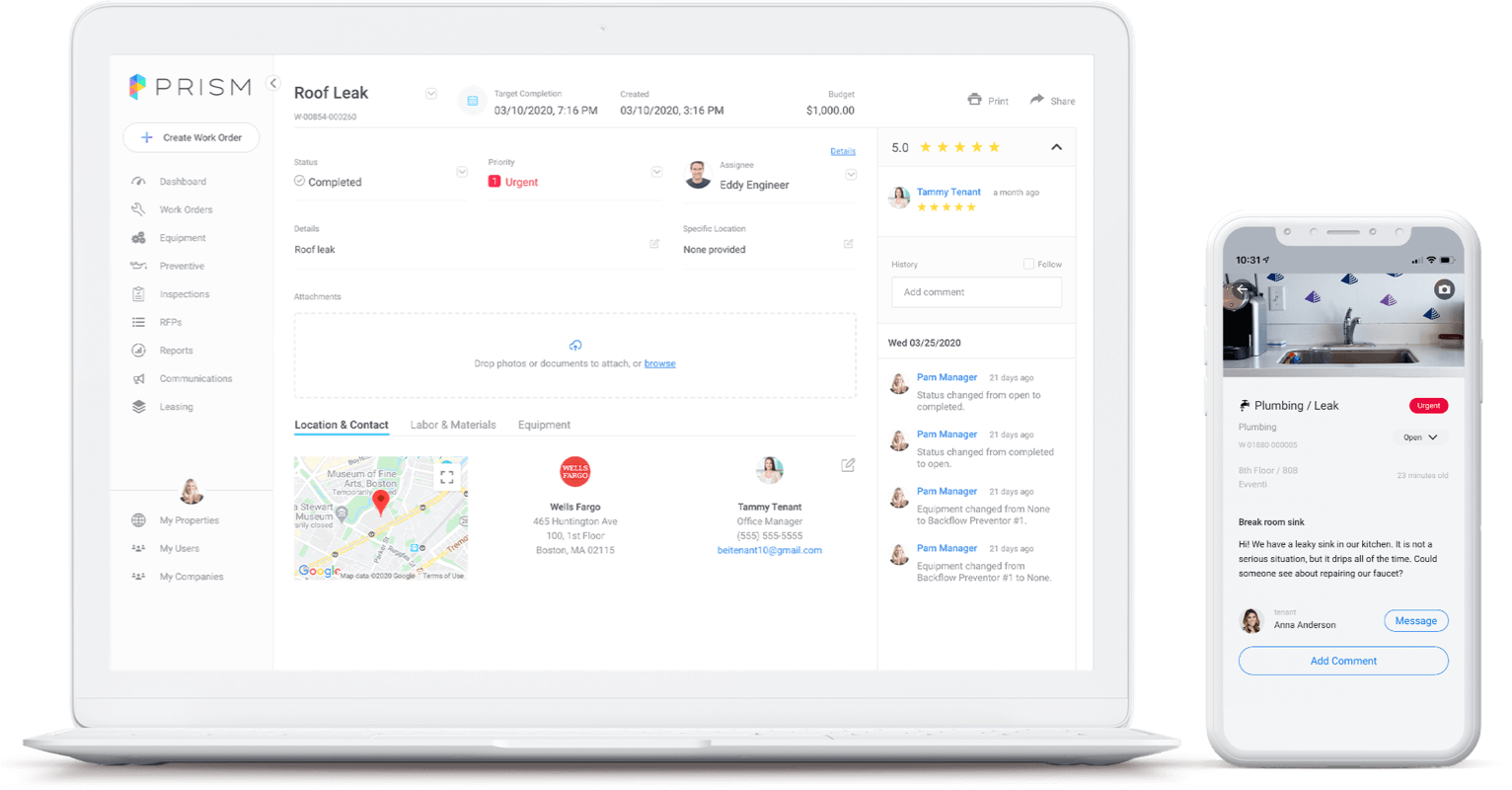
CRE web app for managing +25k buildings
About
17-year old CRE company undergoes a digital transformation
Digital transformations continue to run rampant through every global industry, and technology is no exception. Companies of all sizes continue to undergo digital shifts, including almost two-decades-old software CRE software companies. This part of the story is where Building Engines makes its debut.
Building Engines, acquired by JLL in 2021, is a property management software that connects business operation processes with the tenants and building managers associated with the building. Essentially, Building Engines brings the information to which tenants and managers need ready access and supplies it to them on a newly unified cloud and mobile platform.
What once existed on internal legacy systems has transformed into a digital dream with an easy-to-use dashboard and interface. Such is the appeal of digital transformations, and they create a more leisurely journey for your client, whether you're selling SaaS or operating on a B2C platform.
Today, Building Engines integrates and automates several activities involved in building operations and simultaneously remains highly customizable to fit each user's needs based on their roles. Currently, Building Engines has over 750 clients, handling 25,000 buildings totaling 2.4 billion square feet. Each of these buildings is successfully managed using revolutionary Building Engines software.
The Building Engines platform supports the work of thousands of people associated with every building on the application. Administrators, tenants, vendors, and others responsible for overseeing these properties can log in for instant access to the data they need to work and live more efficiently.
Building Engines understands everything must work seamlessly in building management, from structural maintenance to accounting management. Big name companies utilize this software, including Beacon Capital and Highwoods Properties.
We never recommend name-dropping, but in this case, it's vital to highlight the well-established, reputable, and respected brands that work using this capable application. So often, constructing a new application or software platform thrives on word-of-mouth. While that's true for Building Engines, the company repeatedly proves itself in real-life situations with companies that need near-flawless management.

Challenge
Rewriting legacy code and developing new features
It should go without saying that most of the technologies used in dated systems come with complex maintenance. Building Engines, though still providing some exceptional software, struggled with the core of that software becoming reliant on legacy systems and applications. The challenge for Building Empires existed in the rewriting of legacy code and new feature development.
Upgrading and transforming a company on a digital level can be terrifyingly overwhelming. Even though they have a firm grasp of the ideas that need to spring to life, most companies have no idea where to begin. Building Engines reached out to us in search of a technology partner to support them in the pillars of transforming an application.
Application Rebuilding
There's no denying that Building Engines had an application that worked for them. Still, they needed a way to continue to offer its most beloved functionalities to their clients on a higher operational level. At its core, digital transformation is about the customer journey in addition to the elimination of repetitive tasks and complicated system management.
The Addition of Features
Adding new features to improve the user experience is essential to what we do. The rebuild and feature add-on is based on requests from potential market segments and new clients. With this information, we can see where the application needs the most rework.
Solution
Constant re-engineering
Every technologically-based solution differs from the next. So many factors go into what we create for every client, and we never come across software or applications that require the exact thinking process and solutions as the last. For Building Engines, it was clear that the answer here would be constant re-engineering.
As a company, Building Engines values constant re-engineering to improve product performance, asking it to adapt quickly to the user's needs. The team keeps in constant contact with clients, and our team exists in Colombia and Uruguay and seamlessly worked side by side with Building Engines' in-house team based in Boston. These teams were a great match in many ways, including team dynamics and culture.
The geographic proximity and close time zone between Colombia and the US allowed team members to stay in touch easily. A mere four-hour flight away, the client has also been able to visit our offices in Latin America.
Outcome
This collaboration proves that we remain dedicated to adding new, robust web application technologies, helping to improve its performance, and successfully implementing better coding, refactoring, and testing practices. The goal is to generate scalable and effective software for users’ needs today, considering the product’s growth tomorrow.
Building Engines is constantly expanding to new countries. This expansion means that, besides maintaining flawless performance and UX, developers must consider translating their software to other languages, including Spanish and German. The team works under the Scrum umbrella, adapting Agile processes and ceremonies to fulfill their needs.
Continuous improvement is necessary due to the growing number of buildings managed through the Building Engines application. Every team member is always looking for solutions that could help the product become more automated, intelligent, and optimized.
A good practice they have implemented is an internal training day in which every team on the platform shares their tips and experiences. Lately, we've been working on updating dashboards, filters, and the app’s assignment system so users can tackle issues faster.
Some of the new features in development include building maintenance and inspection, which will be available on the app soon. Feedback is constantly shared with the developers by the support team to identify improvement opportunities. We are continually working toward a better way of doing.

Work process
Step by step
Working with a professional software development company will often bring about a specific work process, though it could differ significantly from other software companies operating within the same sphere. Uruit understands building and updating applications for major brands and global corporations. We believe that every company deserves the same level of dedication from us, regardless of location, size, and project.
Research and Planning
Research and planning begin when we acquire a new client, aiming to answer high-level questions regarding your application and the current market space. We invest a lot of initial time upfront to ensure future success.
The research and planning phase will look very different from client to client, as a new build won't be in the same wheelhouse as an app that needs legacy updates and new features. We stick with our clients through every step of the work process, ensuring they remain in the loop and updated at all times.
The Prototype
Prototyping is an integral part of any application construction. It relies heavily on user feedback, helping to get a good sense of the core functionality of the new app or features. The audience we're developing for remains at the forefront of our path, and it's essential to have an iterative approach so we can present as many options as possible. The prototype is where the app will evolve and adapt.
Design
The design phase of an app contains many components, including the responsibility of the UI and UX designers to refine what's already there. The design phase should produce high-quality mockups our developers can turn into a working application. Brand guidelines are well-established, encouraging consistent, clear branding and application cohesiveness.
Development
Writing the code for the (almost) final version of the app comes in the development stage. Now, we'll use the feedback received in the previous steps to make the big decisions, such as utilizing waterfall or agile methodologies. The integration of analytics during the development phase is critical, allowing us to see how the application flows with your users as we continue to develop the design.
Application Testing
For us, testing usually coincides with the development stage. Continuous testing can keep costs low after the app launches and include unit tests, integration testing, and UI tests, ensuring the elimination of all significant bugs or oversights early on. While testing can sometimes increase the length of the development stage, our clients agree that they're well worth it.
Application Release and Maintenance
The release phase includes submission to the platforms you've chosen to host your application, and your quality application will go live for public availability. We will stay in constant contact, reviewing user feedback and assisting with marketing strategies.
App maintenance begins as soon as the app releases, and progresses simultaneously. We'll provide maintenance for your application by monitoring the status, fixing bugs, and ensuring the app works as expected upon every consumer download. Ongoing app maintenance never ends, and Uruit is up for the job.
Work With Us
Based on our work process and the wild success of this case study, Uruit looks forward to providing as many companies as possible with software solutions that can take their businesses and the applications they run on to a whole new level operationally and, hopefully, financially.
We are bringing the digital revolution to the forefront of the conversation, encouraging our clients to think outside the box while building new platforms that change their user journey and make a difference.
SaaS platform integrates +300 banks in the US
Raisal receives fanfare at a CRE technology conference in New York thanks to its improved UX and performance.
SaaS platform integrates +300 banks in the US
Raisal receives fanfare at a CRE technology conference in New York thanks to its improved UX and performance.

Multiple teams collaborate for updating a CRE SaaS
Improving a nationwide platform of property and listing information for +5K companies in the Commercial Real Estate industry
Multiple teams collaborate for updating a CRE SaaS
Improving a nationwide platform of property and listing information for +5K companies in the Commercial Real Estate industry

Rebuilding a CRE toolkit
Re-building a toolkit to provide data and tools to support Commercial Real Estate professionals
Rebuilding a CRE toolkit
Re-building a toolkit to provide data and tools to support Commercial Real Estate professionals

CRE platform for managing +200K construction projects
Improving the software while migrating to newer technologies.
CRE platform for managing +200K construction projects
Improving the software while migrating to newer technologies.

Building an interactive digital shopping experience in the real world
How we partnered with a leading well-being company to create an incredible shopping experience.
Building an interactive digital shopping experience in the real world
How we partnered with a leading well-being company to create an incredible shopping experience.

Recipe for Digital Product success
How we partnered with Forks Over Knives to build a life-changing solution for its users
Recipe for Digital Product success
How we partnered with Forks Over Knives to build a life-changing solution for its users
